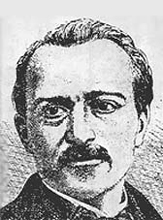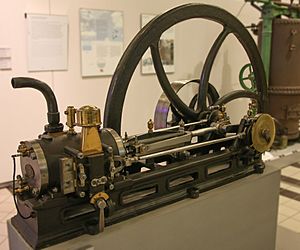Étienne Lenoir facts for kids
Quick facts for kids
Étienne Lenoir
|
|
|---|---|

Jean Joseph Étienne Lenoir
|
|
| Born | 12 January 1822 Mussy-la-Ville, Luxembourg
|
| Died | 4 August 1900 (aged 78) La Varenne-Sainte-Hilaire, France
|
| Citizenship |
|
| Known for |
|
| Scientific career | |
| Fields | Engineering |
Jean Joseph Étienne Lenoir (born January 12, 1822 – died August 4, 1900) was a clever Belgian-French engineer. He is famous for creating the first internal combustion engine that was actually sold and used by many people. While other engines existed before, Lenoir's was the first real success.
Étienne was born in Mussy-la-Ville, a place that was part of Luxembourg back then. In 1838, he moved to Paris, France. There, he became very interested in electroplating, which is a way to coat metal objects using electricity. This led him to invent many electrical things, like a better electric telegraph.
Contents
Lenoir's First Engine
By 1859, Étienne Lenoir used his knowledge of electricity to build his famous engine. This was the first internal combustion engine that used a mix of coal gas and air. A "jumping sparks" system, like a spark plug, ignited the mixture. He received a patent for it in 1860.
His engine was a bit like a steam engine that had been changed to burn gas. It worked by pushing in both directions. The fuel mixture was not squeezed (compressed) before it was lit. This made the engine quiet, but it wasn't very efficient.
In 1863, Lenoir showed off a car called the Hippomobile. It had a one-cylinder engine that ran on coal gas. This car took a test drive from Paris to Joinville-le-Pont. It traveled about 18 kilometers (11 miles) in 3 hours.
Lenoir worked with a company called Petiene et Cie. They helped him start his own companies in Paris in 1859. These companies aimed to build and sell his engines. Even though the engine worked, it used a lot of fuel. It was also very noisy and often got too hot. If it didn't have enough cooling water, it could even stop working.
Despite these issues, people were excited. A newspaper in Paris even said that the age of steam engines was over! By 1865, over 140 of his engines were sold in Paris. Other companies, like Reading Gas Works in London, also started making them.
Lenoir's Early Cars
It's not exactly clear when Lenoir built his first cars, but it was likely around 1860. He built a small carriage with his engine. His 1862 car could travel at about 3 kilometers (1.8 miles) per hour.
In 1861, he put one of his engines into a boat.
In 1863, Lenoir showed off his second three-wheeled car, the Hippomobile. It was basically a wagon body placed on a tricycle frame. This car had a 1.5 horsepower engine that ran on liquid fuel like petroleum. It also had an early type of carburettor.
The Hippomobile successfully traveled 11 kilometers (7 miles) from Paris to Joinville-le-Pont and back. It took about 90 minutes each way. This speed was slower than a person walking! Still, it caught the attention of Tsar Alexander II. One Hippomobile was sent to Russia, but it disappeared, which made Lenoir unhappy.
In 1863, Lenoir sold his engine patents to a gas company in Paris. He then started working on motorboats. In 1888, he built the first boat powered by a four-cycle engine that used a fuel called ligroin. The famous writer Jules Verne even mentioned Lenoir's machines in his 1863 novel Paris in the Twentieth Century.
Engines for Factories and Shops
Most of Lenoir's engines were used as stationary power sources. This means they stayed in one place and powered things like printing presses, water pumps, and tools in factories. However, they became "rough and noisy" after a lot of use.
Other engineers, especially Nicolaus Otto, soon made much better internal combustion engines. This made Lenoir's design less useful. Fewer than 500 Lenoir engines were built, ranging from 6 to 20 horsepower. Some were even made under license in Germany.
Electrical Inventions
In 1865, Lenoir went back to working with electricity. He invented a new kind of automatic telegraph device. This device could send messages in written form. It was very helpful during the Franco-Prussian War. He also put an improved version of his engine into a 12-meter-long boat. A man named Mr. Dalloz used this boat on the Seine River for two years.
French Citizenship and Honors
Lenoir became a French citizen in 1870 because of his help during the Franco-Prussian War. In 1881, he received the Légion d'honneur, a very important French award, for his work in telegraphy. Even though his engine was quite successful, Lenoir became poor in his later years.
On July 16, 1900, just before he passed away, Lenoir received a special award from the ACF (Automobile Club de France). It was a silver plate that said, "In recognition of his great merits as an inventor of the gas engine and builder of the first car in the world."
Lenoir died in La Varenne-Sainte-Hilaire on August 4, 1900.
See also
 In Spanish: Étienne Lenoir para niños
In Spanish: Étienne Lenoir para niños
- Hippomobile
- History of the internal combustion engine
- Lenoir cycle
- Timeline of hydrogen technologies




